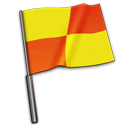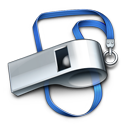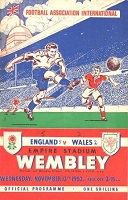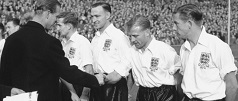|
|
flg.jpg)  "MAGNIFICENT,
PULVERISING! THE REAL ENGLAND AT LAST"
Daily Mirror "MAGNIFICENT,
PULVERISING! THE REAL ENGLAND AT LAST"
Daily Mirror |
  Officials
from Scotland Officials
from Scotland |
England |
UK ruling on substitutes |
Wales |
Referee (black)
Douglas Gerrard
39 (10 March 1913), Aberdeen |
Teams presented to HRH The Duke of Edinburgh KG,
Milwyn Jenkins (FAW Chairman) and Herbert Powell (FAW secretary)
The match fee for the England players
is now raised to £30. |
|
In the previous twelve months, Gerrard
has taken charge in all four home countries, Wales vs. England at Cardiff,
Scotland vs. United States at Glasgow, Ireland vs. England at Belfast, and now at
Wembley! |
|
flame flag
Linesmen
orange flag |
Joseph A.
Coulter
Dumfries |
William Davidson
Kirkcaldy |
|
|
|
flg.jpg) England
Team England
Team |
| |
|
Rank |
No official ranking system established;
ELO rating 4th |
Colours |
The 1949 home
uniform -
White collared jerseys, blue shorts, black socks with white
tops. |
|
P 27th of 43, W 16 - D 6 - L 5 - F
73 - A 39. |
|
Captain |
Billy Wright |
Manager |
Walter Winterbottom, 39 (31 March 1913), appointed as FA national director of coaching/team manager on 8 July 1946; |
|
record 30th of 90, W 19 - D 5 - L 6 - F 75 - A 38. |
P 48th of 139, W 32 - D 9 - L 7 - F 144 - A 57. |
|
|
 ³ ³ |
Team chosen by Selection Committee headed by Harold Shentall, on Tuesday, 4
November. |
flg.jpg) England
Lineup England
Lineup |
|
|
three
changes
to the previous match
(Smith, Froggatt & Bentley>Eckersley, Sewell & Baily) |
league position
(4 November) |
|
|
|
Merrick, Gilbert H. |
30
291 days |
26 January 1922 |
G |
Birmingham City FC
(FL2 8th) |
8 |
10ᵍᵃ |
|
2 |
Ramsey, Alfred E. |
32
295 days |
22 January 1920 |
RB |
Tottenham Hotspur FC
(FL 15th) |
24 |
1 |
|
3 |
Smith, Lionel |
32
81 days |
23 August 1920 |
LB |
Arsenal FC
(FL 7th) |
4 |
0 |
|
4 |
Wright, William A. |
28
280 days |
6 February 1924 |
RHB
/CHB |
Wolverhampton
Wanderers FC (FL TOP) |
45 |
3 |
|
most apps 1952 |
5
 |
Froggatt, Jack, injured off 28th-33rd min. |
29
361 days |
17 November 1922 |
CHB
/OL |
Portsmouth FC (FL
11th) |
10 |
2 |
|
6 |
Dickinson, James
W. |
27
202 days |
24 April 1925 |
LHB
/RHB |
Portsmouth
FC (FL 11th) |
22 |
0 |
7
   |
Finney,
Thomas |
30
221 days |
5 April 1922 |
OR |
Preston
North End FC (FL 12th) |
41 |
21 |
|
718 |
8
 |
Froggatt, Redfern |
28
81 days |
23 August 1924 |
IR/IL |
Sheffield Wednesday FC (FL 8th) |
1 |
0 |
|
the 32nd Wednesday player to represent
England |
9
  |
Lofthouse, Nathaniel |
27
76 days |
27 August 1925 |
CF |
Bolton Wanderers FC
(FL 14th) |
10 |
12 |
|
the
161st (28th post-war) brace scored |
oldest youngest player
so far |
10
 |
Bentley,
T.F. Roy |
28
181 days |
17 May 1924 |
IL/IR |
Chelsea
FC (FL 10th) |
7 |
3 |
11
 |
Elliott, William H. |
27
237 days |
20 March 1925 |
OL/LHB |
Burnley FC (FL 6th) |
4 |
1 |
|
reserves: |
Joe Kennedy (West Bromwich Albion FC
(FL 5th)) and
Johnny Dixon (Aston
Villa FC (FL 13th)). |
|
team notes: |
The Froggatt's are
cousins. Jack Froggatt received treatment for a damaged shoulder after
28 minutes, sustained during Wales' first goal, in a tussle between
him and Ford. It meant that Billy Wright became the centre-half for
England for the first time.
Redfern Froggatt becomes Winterbottom's 76th player.
Following the match, after the players returned to their dressing
rooms, Lionel Smith collapsed. An ambulance was called and he spent
the night in Wembley Hospital, suffering with exhaustion. |
|
appearance notes: |
Nat Lofthouse is the youngest player of
the eleven starting the match, thus breaking a record set in 1912 by
Jock Simpson, by 293
days. Lofthouse will be the oldest youngest player until the next match. |
|
goalscoring notes: |
The brace from Nat Lofthouse, his fifth, and the sixth player to do
so, but the first since George Camsell in 1933, is also the first time
a player has scored twice at the Empire Stadium since the two were
scored
against Scotland in April 1930. |
|
records: |
This victory beats the post-war
unbeaten record. England have gone twelve
games without loss, beating the record set between 1947-48. |
|
The England team were, as per usual, set up in Hendon prior to this
match, training at Chelsea FC's Stamford Bridge. |
|
|
|
2-3-5 |
Merrick
-
Ramsey, Smith -
Wright, J.Froggatt, Dickinson
-
Finney, R.Froggatt, Lofthouse, Bentley, Elliott.
notes:
for the second half, Wright instructed himself to centre-half, and Dickinson to
the right, and Billy Elliott took up the vacant left-half position.
Then Redfern and Bentley swapped wings. |
|
Averages: |
Age |
29 years 179
days |
Appearances/Goals |
16.0 |
3.5 |
|
|
|
 Wales
Team Wales
Team |
| |
|
Rank |
No official ranking system established;
ELO rating 20th |
Colours |
Made by Umbro -
Red collared jerseys with white collars/cuffs, white shorts with red side stripe, red socks
with white tops. |
|
Captain |
Ron Burgess |
Selection |
Selection Committee
on Tuesday, 4 November 1952 |
 Wales
Lineup Wales
Lineup |
|
|
Shortt, William W. |
32
30 days |
13 October 1920 |
G |
Plymouth Argyle FC, England |
9 |
13ᵍᵃ |
|
2 |
Stitfall, Ronald F. |
26
334 days |
14 December 1925 |
RB |
Cardiff City FC |
1 |
0 |
|
3 |
Sherwood, Alfred T. |
28
1 day |
13 November 1923 |
LB |
Cardiff City FC |
24 |
0 |
|
4 |
Paul, Roy |
32
208 days |
18 April 1920 |
RHB |
Manchester City FC, England |
20 |
1 |
|
5 |
Daniel, W.
Raymond |
24
10 days |
2 November 1928 |
CHB |
Arsenal FC, England |
9 |
0 |
|
6 |
Burgess, W.A.
Ronald |
35
217 days |
9 April 1917 |
LHB |
Tottenham Hotspur FC, England |
25 |
1 |
7
 |
Foulkes, William I. |
26
169 days |
29 May 1926 |
OR |
Newcastle United FC, England |
6 |
1 |
|
8 |
Davies, E. Reginald |
23
171 days |
27 May 1929 |
IR |
Newcastle United FC, England |
2 |
0 |
9
  |
Ford, Trevor |
29
42 days |
1 October 1923 |
CF |
Sunderland AFC, England |
25 |
19 |
|
mst goals |
|
10 |
Allchurch, Ivor J. |
22
332 days |
16 December 1929 |
IL |
Swansea Town FC |
10 |
4 |
|
11 |
Clarke, Royston J. |
27
167 days |
1 June 1925 |
OL |
Manchester City FC, England |
15 |
4 |
|
reserve: |
David Bowen (Arsenal FC) |
|
team changes: |
Liverpool FC's Ray Lambert was the original chosen right-back. He
pulled a thigh muscle in his club's league match against Middlesbrough
on Saturday. His placing going to Stitfall on the Monday. |
|
The Welsh
team were set up in Weybridge prior to this match and trained on a
recreation ground near to their hotel, for this, their first ever
visit to Wembley. |
|
|
|
2-3-5 |
Shortt -
Stitfall, Sherwood -
Paul, Daniel, Burgess -
Foulkes, Davies, Ford, Allchurch, Clarke |
|
Averages: |
Age |
28 years 55
days |
Appearances/Goals |
13.3 |
2.5 |
|
|
|
|
Match Report by
Mike Payne |
|
 For
the first time, England took their home match with Wales to Wembley. The
teams celebrated this event by providing the stadium with a memorable game
and a magnificent spectacle for the crowd. For
the first time, England took their home match with Wales to Wembley. The
teams celebrated this event by providing the stadium with a memorable game
and a magnificent spectacle for the crowd.
Some 93,500 people
paid a record £43,600 and greeted the sides with a tremendous cheer as
they strode on to the lush green grass which was bathed in warm sunshine.
The white and scarlet jerseys made for a colourful scene and amongst the
crowd was the Duke of Edinburgh.
From the start both
teams played attacking football. England quickly moved into a smooth
flowing rhythm and all their forwards looked dangerous. The passing was
swift and accurate and the home side's teamwork became the outstanding
feature of the game.
Soon the Welsh was struggling and, within ten
minutes, England were 2-0 up. The first goal was as a result of a lovely
move. Redfern Froggatt began the move with a pass to Nat Lofthouse. He
quickly moved it on to Tom Finney, whose centre was touched on by Roy
Bentley to Billy Elliott on the left. The Burnley star quickly turned the
ball back across goal to find Finney, now in the middle, who shot a fine
goal past Shortt.
Shortly afterwards came the second goal. Elliott
took a corner on the left and, as the cross came over, Redfern Froggatt
cleverly flicked the ball to Lofthouse and the number nine scored from
close range.
It looked as though England were going to run up a
cricket score but, quite unexpectedly, Wales pulled a goal back after 15
minutes.
Ford, always a real handful for Jack Froggatt, found
himself competing with the centre half for a high bouncing ball in the
area. Ford won the duel and latched on to it nodding it down with his head
before crashing a low shot past Gil Merrick with his right foot.
This put a different complexion on the scoreline and on the half-hour
another incident seemed to offer Wales further hope. Again Jack Froggatt
and Ford clashed for a 50-50 ball but this time the England player was
injured. As he was carried off the crowd thought that it was the last they
would see of him in this game. How wrong they all were.
Within ten
minutes, he came back on to the field to a tumultuous welcome. His injury
meant that he would have to line-up on the left wing, a position he used
to play and England reorganised completely to accommodate him. It was
quickly obvious the changes were not going to affect their general play.
Redfern Froggatt, Finney and especially Lofthouse were magnificent in
restoring England's superiority. Mere words cannot convey the superb
contribution of Finney to England's cause and Lofthouse gave his best
performance so far in the purple patch that he is in. He gave Daniel a
torrid time both in the air and on the ground. Just before half-time,
England took a 3-1 lead through an unlikely source.
Finney, turning
brilliantly, fired in a shot which was going wide of the far post, that
is, until the large figure of Jack Froggatt came from nowhere to dive
forward to head home. The roar that greeted the goal must surely have been
heard in Cardiff. Incredibly before the break he nearly added another only
to be foiled by the legs of Shortt.
England continued with their
magical play after half-time. Almost immediately it was 4-1. Another
superb Finney, Lofthouse combination gave Bentley the chance to shoot a
fine goal from twenty yards.
Wales, who all the time played open
attractive football, showed their character a minute later by pulling a
goal back. Again Ford was on target latching on to a Foulkes shot that
bounced off Lionel Smith.
England continued to turn on the style,
though, and with 15 minutes left, Lofthouse capped a marvellous
performance with a fifth and final goal. His fierce shot from 25 yards was
far too hot for Shortt to handle and the ball went in despite the
goalkeeper's attempted save.
It had been a memorable match with
outstanding performances from many, if not all, of the 22 players.
|
|
Match Report by
Norman Giller |
|
This was the first time Wales had ever played
at Wembley, and a Wednesday afternoon crowd of 93,500 paid record gate
receipts of £43,000. England were two goals up in the first ten
minutes through Tom Finney and Nat Lofthouse. Five minutes later Trevor
Ford pulled a goal back for Wales, and was then involved in a collision
with Jack Froggatt that led to the England centre-half being carried off.
Billy Wright switched to the middle of the defence, with Billy Elliott
dropping back from the wing to left-half. Jack Froggatt, whose cousin,
Redfern, was making his debut at inside-right, came back on as a passenger
on the left wing.
Remarkably, it was Jack who scored England's third goal just before
half-time with a brave diving header. Roy Bentley made it 4-1 in England's
first attack after half-time, with Ford instantly replying for Wales. Nat
Lofthouse rounded off the scoring with a shot from twenty-five yards that
goalkeeper Bill Shortt could only help into the net. The significant thing
about this match was that it was the first time that Billy Wright played at
centre-half for England.
|
|
Match Report by
Glen Isherwood |
|
Having made three visits in wartime, Wales now
appeared at Wembley in the British Championship for the first time. They
had not beaten England in the competition since 1938 but had shared the
title with them the previous season. England had already drawn 2-2 with
Northern Ireland at Windsor Park, but Wales had lost 2-1 to Scotland at
Ninian Park and had to avoid defeat to continue their interest in the
Championship.
England scored
twice in the opening ten minutes. After some early pressure Tom Finney
converted an Elliott centre. The second came from an Elliott corner. This
time a flick-on from Redfern Froggatt supplied Nat Lofthouse with a goal.
Within five minutes Wales had pulled one back.
Trevor Ford fought off the challenge of Jack Froggatt to shoot past
Merrick. Froggatt was later stretchered off but then returned to play out
on the wing and then miraculously met Finney's cross with a diving header
to score England's third.
In the second half Lofthouse and Finney
combined to set up Roy Bentley with a chance to shoot and score from just
outside the penalty area.
Wales almost immediately scored again
when a Foulkes shot was blocked by Smith but fell to Ford to score his
second with a cheeky back-heel. Lofthouse completed the scoring with 15
minutes left when his 25-yard shot went crashing through Shortt's hands.
Wales ruined Northern Ireland's chances by beating them 3-2 at Windsor
Park and the Championship was concluded at Wembley.
|
|
Match Report
as appears in the F.A. Yearbook 1953-54, page 21 |
|
For the match against Wales England
made three changes: Smith replaced Eckersley in the defence, and Frogatt
(R.) and Bentley were the new inside-forwards to take the places of Sewell
and Baily. Wales, appearing for the first time at Wembley (apart from
matches during the war), made only one change from the side narrowly
beaten by Scotland in October. Lambert was chosen to replace Lever at
right-back but he was injured and Stitfall came in at the last moment.
Without a doubt England played well, and a good Welsh side was unlucky to
be baptised at Wembley in such devastating fashion. It was a great
attacking match - seven goals tell the tale - and the English forwards
played with a new rhythm and understanding. Lofthouse emerged from the
game as the complete centre-forward, foraging, holding his line together
magnificently, and shooting hard and true at every opportunity. Combining
wonderfully with a Finney showing all his supreme artistry, Lofthouse
quickly won the middle of the field for England, and his inside-forwards,
Froggatt (R.) and Bentley - who changed places early on - were quick to
take advantage. A hero, too, was Froggatt (J.), hurt in a crash with Ford
after half-an-hour and carried off on a stretcher. He returned to play a
challenging part at outside-left, his old position, and when Wales were
fighting back after the interval, it was he who hurtled through the air to
head home Finney's cross to give England a secure lead.
England scored
twice in the first 10 minutes, first through Finney, then through
Lofthouse. Yet, within moments Ford beat Froggatt (J.) to a bouncing ball,
nodded it down to his foot and cracked home a fine shot. After the
interval and Froggatt's great-hearted goal, Bentley put England further
ahead before Ford scored Wale's second. Then, a quarter of an hour from
the end, Lofthouse crowned a great display with such a fierce shot from 25
yards that, although Shortt got his fingers to it, he was unable to
prevent it going over his head into the net.
|
In
Other News....
|
It was on 12 November 1952 that the Duke of Edinburgh had
his first flying lesson prior to attending the match at
Wembley. In perfect flying conditions, he was
taken up in a Chipmunk from White Waltham Airfield in
Berkshire for 35 minutes. 18 months later, he earned his
Royal Air Force 'wings' to be displayed on his uniform and,
over a period of 45 years, achieved almost six thousand
hours of flying time. |
|
|
|
|
|
|
Source Notes |
TheFA.com
Original newspaper reports
Wales' Complete Who's Who
since 1946
Drew Herbertson, Scottish FA historian |
|
Rothman's Yearbooks
Mike Payne's England: The Complete Post-War Record
Norman Giller, Football Author
Glen Isherwood's Wembley: The Complete Record
British Pathé |
|
|
cg |

1947.JPG)
